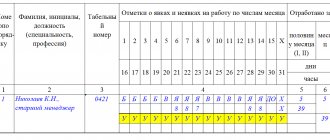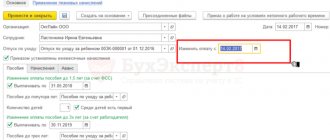How is leave granted during part-time work?
Chapter 19 of the Labor Code of the Russian Federation regulates the provision of leave to citizens. The annual basic leave is 28 days, except in cases where it can be increased. Thus, according to Art. 115 of the Labor Code of the Russian Federation, the law does not provide for less than 28 days of vacation for a full year of work. Accordingly, employees who work part-time are also entitled to 28 days of rest. This is confirmed by Art. 93 of the Labor Code of the Russian Federation, which prohibits introducing any restrictions for citizens who work in a mode other than the standard one.
Leave for part-time work is granted in the same way as for part-time work:
You can find more complete information on the topic in ConsultantPlus. Full and free access to the system for 2 days.
- The employee writes a statement, having previously calculated the vacation period.
- The application is endorsed by the employee's immediate supervisor.
- The HR department checks the correctness of the employee's calculation of the duration of vacation and submits the document to the head of the enterprise for signature.
- An order is issued, which the employee reads and signs.
ConsultantPlus: Forums
Answer: Based on the norms of Article 115 of the Labor Code of the Russian Federation, annual basic paid leave is provided to employees for a duration of 28 calendar days.
At the same time, the procedure for granting vacations when working part-time is determined by the norms of Art.
Time spent caring for a child when the employee worked part-time is counted towards the length of service to provide annual paid leave. Justification: According to Art. 256 of the Labor Code of the Russian Federation, at the request of a woman while on maternity leave, she can work part-time or at home while maintaining the right to receive state social insurance benefits.
The legislation does not establish the need to interrupt parental leave when providing annual paid leave. Since the employee works during maternity leave, this time is counted towards the length of service for the provision of annual paid leave (Art.
Vacation and calculation of vacation time for part-time work
Let us dwell in more detail on the issue of calculating the so-called vacation experience, which must be worked out in order to receive vacation. The legislator does not introduce any special rules for calculating length of service for workers for whom a part-time work regime has been introduced, so you need to focus on the provisions of Art. 121 Labor Code of the Russian Federation. According to this norm, the length of leave includes any time of work and rest, with the exception of time away from work for unexcused reasons and time spent on parental leave.
Let's look at an example. A citizen works 2 days a week - accordingly, the following days will be included in the length of service:
- Monday and Wednesday - as working hours;
- Tuesday, Thursday, Friday, Saturday, Sunday - like days off.
IMPORTANT! The only exception is when it comes to additional leave granted for work in harmful or dangerous conditions. In this case, the length of service giving the right to leave should include only the days actually worked under such conditions.
Under harmful, dangerous conditions
It is established according to the rules in force for all workers (Part 4 of Article 93 of the Labor Code of the Russian Federation): at least 28 days in calendar terms per year of work. For the first time it is granted after six months of performance of labor duties.
Time is excluded (list in parts 1, 2 of Article 121 of the Labor Code of the Russian Federation):
- absence of a worker without good reason;
- absence from child care until the age of 1, 5, or 3;
- absence without pay for more than two weeks in a working year.
Time is counted:
- performance of duties;
- travel for work;
- sick leave;
- weekends, holidays;
- vacations, except for child care;
- temporary downtime due to the fault of the employer;
- when a worker who was unable to undergo a medical examination due to someone else’s fault was suspended from performing work duties;
- absenteeism of an illegally dismissed employee who was subsequently reinstated;
- absence without pay, less than two weeks per year of work.
The working year begins on the date the worker is hired. Excluded periods shift the end of the year by the corresponding number of days.
The principles by which short-term vacations are granted are the same for everyone. According to Art. 125 of the Labor Code of the Russian Federation, a worker, by agreement with the administration of the enterprise, uses paid vacation, provided annually, in parts, if one part is at least 14 days.
Let’s say, according to a written application to the bricklayer, E.N. Sterkhov, the administration of Stroitelny Mir LLC reduced the duration of the shift from 8 to 4 hours. The shift will be counted as a full shift if Sterkhov E.A. will work the time assigned to him by the administration.
Calculation of vacation pay for part-time work in 2019
The calculation of vacation pay for part-time work in 2020 is made according to general rules that apply to all employees. It would be incorrect to assume that if a citizen works part-time, then he has not completed his vacation period in full. Even if an employee works 1 day a week and rests the rest of the days, this does not reduce the number of days of vacation, but only reduces the amount of payments (payment for vacation for part-time work is made, as in the case of regular vacation, based on average earnings).
Subscribe to our newsletter
The algorithm for calculating payments for vacation for a part-time working day (partial week) is as follows:
- The calculation period is determined (12 months before the vacation). For example, if an employee goes on vacation on 06/01/2019, the calculation period will be from 06/01/2018 to 05/31/2019.
- The number of days worked in each month is calculated in accordance with Art. 139 Labor Code of the Russian Federation and paragraphs. 5, 10 of the Decree of the Government of the Russian Federation “On the peculiarities of the calculation procedure...” dated December 24, 2007 No. 922.
- The employee's average daily earnings for the year are calculated in the manner prescribed by Art. 139 of the Labor Code of the Russian Federation and clause 9 of Decree of the Government of the Russian Federation No. 922.
- The amount of vacation pay is determined by multiplying the average daily earnings by the number of vacation days.
The number of days worked is calculated as follows:
- If the employee worked full time for a month, then the time worked is 29.3 days. This figure is obtained by dividing the difference between the number of days in a year (365) and the number of holidays (14) by the number of months in a year (12). Not only working days are considered days worked, but also weekends, since the employee was employed. These do not include days of any vacation, business trips, sick leave and days off from work with pay.
- If the month is not fully worked out, the number of days is calculated using the formula:
Days worked / Calendar days × 29.3.
To calculate the average daily earnings, the sum of all payments to the employee for the year, except for vacation pay, benefits, travel allowances and swearing. assistance must be divided by the number of days that the employee worked during the year.
Note: all of the above formulas are applicable to employees who are on a part-time basis, without reservations.
In order to ensure that the calculation of vacation pay does not include months when the employee worked part-time, and, accordingly, the amount of vacation pay does not decrease, the employer may provide in the local act of the enterprise an option for calculating average earnings, different from what the legislator proposes in Art. 139 Labor Code of the Russian Federation. The provisions of the article do not prohibit such actions; they only do not give the employer the right to change the employee’s position for the worse compared to the law. Thus, in a local act you can indicate that only months worked in full are included in the calculation period.
***
An employee's part-time work does not in any way affect the duration and amount of his leave. the number of vacation days for such an employee, as well as for others, is 28 calendar days. The amount of vacation pay is calculated based on the employee’s average daily earnings for the last 12 months.
Employees who work part-time, of course, receive a salary depending on the number of hours worked or work completed <1>. How do you calculate vacation time for such employees? How to determine the duration of their vacation? Is it necessary to recalculate the average monthly number of calendar days for them - 29.3, since they work less?
How is the number of vacation days calculated?
Vacation involves the absence of an employee from the workplace, but maintaining all the conditions provided for in the employment agreement, including his position. In some cases, vacations are paid based on average earnings. The duration of the rest period is determined by the type of break from work. The following options are available:
- Basic annual;
- For expectant mothers;
- Additional;
- For child care;
- Unpaid, due to personal circumstances;
- Designed for learning.
The number of vacation days is calculated depending on the specific type of vacation and the characteristics of its provision in accordance with the Labor Code of the Russian Federation.
Annual leave
The main leave must be issued to each employee of the organization annually (Article 114 of the Labor Code). Anyone who has worked in a company for more than 6 months has the right to it (Article 122 of the Labor Code). In some cases specified in this paragraph, vacations may be granted before the expiration of the allotted period.
Vacation for subsequent years is given in accordance with the approved schedule, which is formed by the employer, based on the production conditions in the company. The order of priority is mandatory for both the administration and the worker.
This is paid leave, the amount of payment is determined based on average earnings. The duration of rest, in accordance with Article 115 of the Labor Code of the Russian Federation, must be at least 28 days . They are calculated in calendar form, the period includes weekends, but does not add up to holidays. Some categories of citizens are granted extended basic rest (for example, teachers).
This is important to know: Refusal to grant leave to an employee
Article 126 of the Labor Code provides that if the duration of rest fixed in the contract exceeds 28 days , the employee has the right to receive compensation for an increased number of days or only part of them. To do this, the citizen needs to write an application addressed to the manager. The rule does not apply to the following employees:
- Women expecting a baby and employees under 18 years of age (all types of leave);
- Working in conditions recognized as harmful to the body (only for additional rest).
The full number of days is recorded for a period called the working year. It differs from the calendar calendar in that it starts not from January 1, but from the date and month of admission to the company. If a person entered into an agreement on 02/02/2018, then from this date the first working year will begin, which will end on 02/01/2019. Some periods, according to Article 121 of the Labor Law, are not included in this length of service, these include:
- Unpaid holidays exceeding 14 days per working year.
- A break from work to raise a child up to 3 years old .
- All periods of absence if the reason for the event is considered unexcusable.
The end date of the working year is shifted by the number of days of the specified periods. The total number of days, according to Article 125 of the Labor Code, may be divided into parts if there is consent of both parties to the employment contract and one of the fragments exceeds 14 days. The same clause provides for the possibility of interrupting rest if necessary.
The main rest, in accordance with Article 124 of the Labor Code, must be extended if there are grounds (for example, if it coincides with sick leave).
It is also possible to postpone the holidays to another date if production circumstances require it, or the employee agrees with the administration.
Additional
In some cases, a worker may be granted additional days of vacation. They can be provided as an annual holiday, or as a one-time event for medical rehabilitation. Based on Article 116 of the Labor Code, in order to receive an additional number of vacation days, it is necessary that the work be related to the following circumstances:
- Factors of the place of performance of duties that are recognized as harmful or dangerous to the body. The minimum number of vacation days is 7 (Article 117 of the Labor Code).
- The territorial location of the company is in the Far North or similar territories. The duration is 24 and 16 days, respectively (Article 321 of the Labor Code).
- Incorporation in the employment contract of conditions regarding non-standard working hours. Vacation cannot be less than 3 calendar days (Article 119 of the Labor Code).
- The special nature of work activity.
Separate regulations at the federal level may provide for the provision of additional holidays to other groups of employees, as well as different durations of breaks. The company also has the right to establish in its local regulations additional conditions for the provision of such leaves.
When a worker has several reasons for taking added vacation days, they must be summed up.
Such vacation is provided in conjunction with the main vacation.
Under hazardous working conditions
The presence of certain dangers in the workplace that could harm an employee gives the right to receive at least 7 days of rest in addition to the main one.
Specialists who conduct research on labor factors have special accreditation and perform such assessments at least every 5 years.
The conditions under study can be classified into one of several groups described in Law No. 426-FZ of December 28, 2013:
- Dangerous (4) . Factors found in the work environment pose a threat to life or contribute to the formation of an acute illness under professional influence.
- Harmful (3) , where there are several subclasses. Conditions that significantly affect the body of an employed person, causing health changes of varying severity - from mild harm to health to complete loss of ability to work. The rest period established by the Labor Code does not allow returning to the previous level of functioning.
- Acceptable (2) . Factors surrounding the place of activity affect the body, but do not create any particular harm, do not violate hygienic standards, or a person can fully restore strength during periods of rest guaranteed by law.
- Optimal (1) . Excellent conditions have been created that either do not affect the employee, or their impact is minimal and does not violate the requirements. Conditions contribute to the fruitful activity of the worker.
If, based on the results of the assessment, the factors at a particular place of work are assigned to 3 or 4 , the worker will have the opportunity to secure additional rest. An employee's part-time working regime does not impose restrictions on the provision of rest.
Vacation experience
The vacation period of employees with part-time work and (or) part-time work week is calculated in exactly the same way as for ordinary employees <1>. That is, it must include all the same periods as other employees. In this case, working days, including part-time ones, and all weekend days in case of a part-time work week are counted towards the time of actual work <2>.
For example, if an employee works 4 hours 3 days a week - Tuesday, Wednesday, Thursday, then he must include in his vacation experience:









